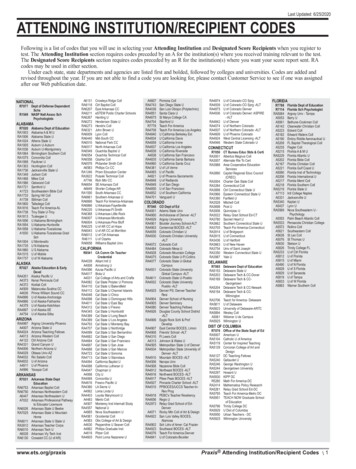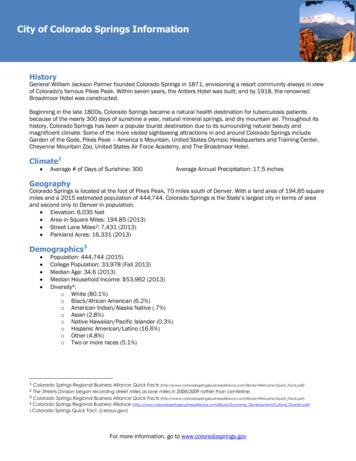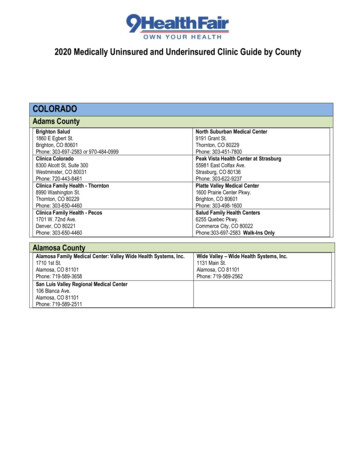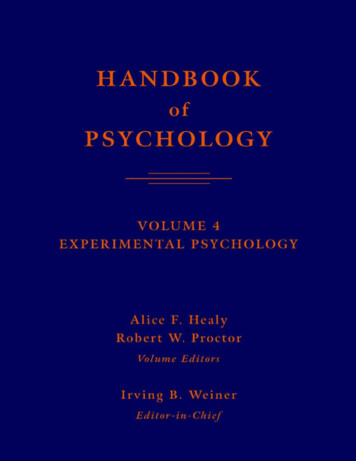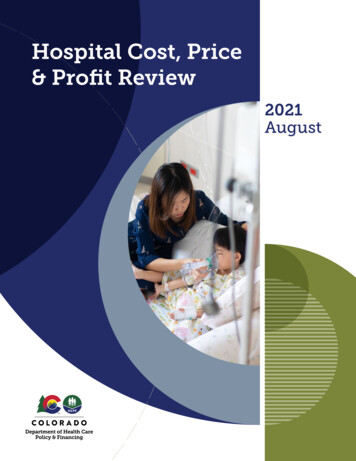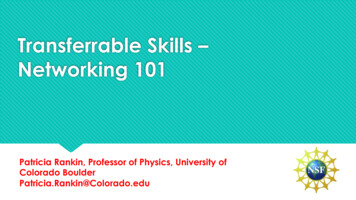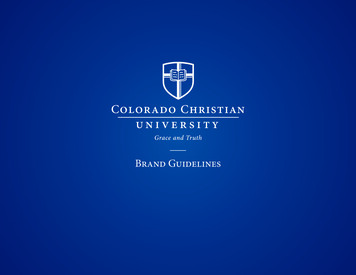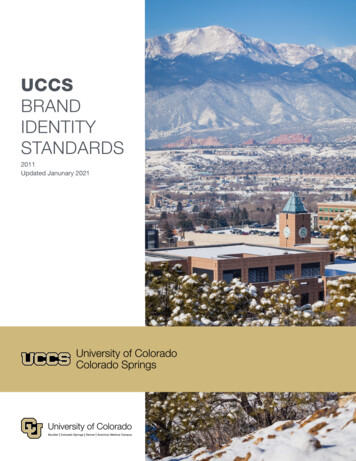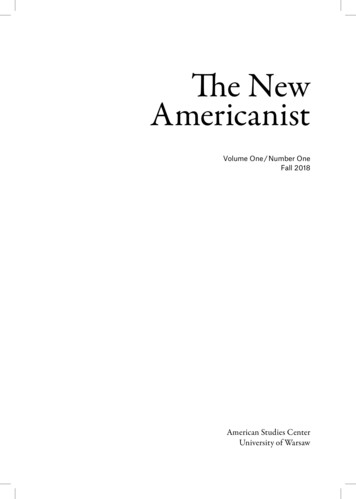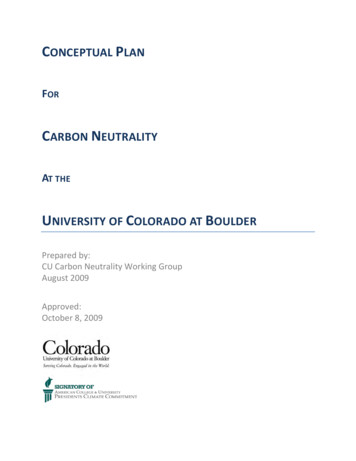
Transcription
CONCEPTUAL PLANFORCARBON NEUTRALITYAT THEUNIVERSITY OF COLORADO AT BOULDERPrepared by:CU Carbon Neutrality Working GroupAugust 2009Approved:October 8, 2009
Conceptual Plan for Carbon NeutralityThis page intentionally left blank1
Conceptual Plan for Carbon Neutrality2
Conceptual Plan for Carbon NeutralityUniversity of Colorado at BoulderCarbon Neutrality Working Groupc/o Environmental CenterUniversity Memorial Center, 355207 UCBBoulder, Colorado 80309-0207(303) 492-8308www.colorado.edu/ecenterAugust, 2009Frank Bruno, Vice Chancellor for AdministrationUniversity of Colorado at Boulder24 UCBBoulder, Colorado, 80339Dear Vice Chancellor Bruno,The Carbon Neutrality Working Group is honored to have been given the opportunity to contribute to the historicclimate action efforts being pursued by CU leadership. Accordingly, we are proud and excited to transmit this“Conceptual Plan for Carbon Neutrality at the University of Colorado at Boulder.”While numerous current faculty, staff, students and community members contributed mightily to this effort, itwould not have been possible without the collective legacy of leadership of the many CU and Boulder communitymembers who have championed sustainability for decades before us.Likewise, we are very appreciative of our team leaders who contributed countless additional hours to coordinatingand refining data and information as this report took shape. Moe Tabrizi, Curt Huetson, John Morris, Ghita Carroll,Rob Hall, Casey Jones, and Erika Smith all deserve special recognition for their time and dedication.Our student staff also committed valuable hours to this effort as well. Special thanks are deserved for LisaBingham, Brad Queen, Dan McGrath, Jessie Lucier, Celene Sheppard, Jacob Golding and Dan Omasta withoutwhom this report would not have been completed.The above students were also central to the preparation and testing of CU’s own carbon emissions projectionmodel, prepared in cooperation with the Boulder County Office of Sustainability. That model was later tested andaffirmed by scientists at the National Renewable Energy Laboratory to whom we also own special thanks. Themodel underpins all the carbon analysis in this report and establishes a credible platform from which to launchCU’s entire carbon neutrality effort. We are very appreciative of everyone’s efforts on that pivotal element of thisplan.Many others also added value and insight to this effort; too numerous to all thank here but deeply appreciatednonetheless.Finally, I personally appreciate the degree of professionalism and support from all members of the Vice ChancellorsOffice staff, particularly Robin Bryant, Kristin Epley, and Maureen Holland who worked tirelessly to facilitatemeeting, revise documents, and shortcut roadblocks. Thanks to all.Respectfully submitted,Dave Newport, ChairCarbon Neutrality Working Group3
Conceptual Plan for Carbon NeutralityAcknowledgementsThe report was prepared under the guidance and auspices of CU’s Carbon Neutrality Working Group, originallyappointed in October 2007: Carl Koval, Renewable and Sustainable Energy Initiative Director/faculty Casey Jones, Director, Parking and Transportation Services Celene Sheppard, Law/ENVS Graduate student Curt Huetson, Operations Director, Housing and Dining Services. Dave Newport, Environmental Center Director, [Chair] Doug Arent, Director, Renewable Energy Systems, National Renewable Energy Laboratory Erika Smith, Budget Director Ghita Carrol, Student, ENVS Ph.D. candidate John Morris, Director, Physical Plant, Facilities Management Moe Tabrizi, Director, Conservation and Engineering, Facilities Management Monceif Karti, CU Building Systems Engineering faculty Paul Chase, Student, ENVS senior Paul Komor, CU Environmental Studies/Civil Engineering faculty Rob Hall, Energy/Climate Program manager, Environmental Center Robin Newsome-Suitts, Vice Chancellor of Administration office Ron Reid, Director, Business Services, Facilities ManagmenetAdditional participants and contributors Andrelino Cardoso, University Memorial Center Ann Livingston, Boulder County Sustainability Director Brad Queen, Graduate Student Dan McGrath, Graduate Student Dan Omasta, ENVS student Ed von Bleichert, Facilities Management Sustainable Operations Manager Jack DeBell, Environmental Center, Recycling Development Manager Jacob Golding, ENVS student, UCSU Sustainability Director Jessie Lucier, Graduate Student John Hallett, INVST Community Studies Program Kristin Epley, Assistant to the Vice Chancellor for Administration Lauren Heising, Housing and Dining Services Lisa Barlow, ENVS faculty Lisa Bingham, MBA, MS candidate Marianne Martin, Environmental Center Associate Director Mark McCaffery, CIRES faculty Patrick Kociolek, Director, Natural History Museum Paul Leef, Campus ArchitectPrimary authorsDave Newport, Lisa Bingham, Brad Queen, Dan McGrathEditorsKristin Epley, Jessie Lucier4
Conceptual Plan for Carbon NeutralityContents1Executive Summary . 82Introduction . 103Hedging Carbon Risk . 123.14Costs and Impacts from Three Types of Carbon Risk. 12CU’s Carbon Footprint. 184.1Three Types of Carbon Emissions . 184.2Inventory . 194.3Carbon Emissions Trend Projection . 224.3.14.46Carbon Mitigation Plans. 234.4.1Carbon Model, Scope 1 and 2 . 234.4.2Phasing . 254.4.3Governor’s Executive Order . 264.4.4Phase 1: Conservation and Efficiency . 274.4.5Phase 2: Large Scale Renewables . 284.4.6Phase 3: Innovative Technologies . 294.55CU’s Reference Trend . 22Emission Reduction Projects . 304.5.1Ongoing, New, and Future Projects . 304.5.2Overall Timeline . 35Financial Analysis . 365.1Financial Modeling . 365.2Aggregate Financial Impacts . 415.3Funding Opportunities . 42Carbon Mitigation Plans, Scope 3 . 436.1Commuting. 436.2Air Travel . 466.3Materials Management . 476.4Upstream Carbon Mitigation Leadership. 496.5Reducing Upstream Carbon Emissions from Materials . 506.6Reducing Upstream Carbon Emissions from Food . 525
Conceptual Plan for Carbon Neutrality7Synergies . 597.1Synergies between Carbon Action and Existing Campus Planning . 597.2Flagship 2030 . 627.3Campus Master Plan . 637.4Academic Plans . 647.4.1Curriculum and Other Educational Experiences . 647.5Research Plans . 697.6Existing Programs and Policies . 717.7Reaching a Carbon Neutrality Date. 798Conclusion . 809Appendices . 839.1Appendix 1 – CU GHG Emissions Worksheet . 859.2Appendix 2 – NREL Letter and CU’s Response . 869.3Appendix 3 – ACUPCC Letter. 899.4Appendix 4 – ACUPCC Background . 909.5Appendix 5 — Project Descriptions . 92Cogeneration. 92Wind Farm. 93Solar Thermal Installations – Rooftop & Concentrated Systems . 96LEED Gold Plus for New Buildings and Major Capital Renovations . 100Heat Recovery in University Laboratories. 102Chilled Water Optimization . 103Roofing Insulation and Painting . 104Windows – Replacement, Sealing, and Weather-Stripping . 106Installing Room Occupancy Sensors . 108Pipe Insulation. 109“Smart” Power Strips for the Dormitories . 110Energy Conservation in the Data Centers . 112General Equipment Cost Sharing Program . 113Carbon Price Risk Factor . 114Behavior Conservation Program Fund . 116Conversion to Duplex/Quad Printers . 1186
Conceptual Plan for Carbon NeutralityImplementation of Diversion Potential Assessment Recommendations . 119Alternate Fuel Vehicle Revolving Loan Pool . 121Fleet Resizing . 122Student Parking Ban . 124Telecommuting/Flex Scheduling . 125Kitchen Efficiency . 1279.6Appendix 6 — Academic Assets . 1291. Existing Research Institutes, Centers, and Initiatives . 1292. Current Academic Programs . 1323. Student Organizations and Groups . 1344. Campus- Wide Behavioral Change Programs . 1375. Faculty Workshops and Education to Faculty . 1386. Campus Events . 1389.7Appendix 7 — Emission Reduction Projects, External Activities & Developments . 1409.8Appendix 9— Carbon Model Data . 1447
Conceptual Plan for Carbon Neutrality1Executive SummaryAs an original signatory to the American College and University Presidents Climate Commitment(ACUPCC) in 2007, the University of Colorado at Boulder formed the Carbon Neutrality WorkingGroup (CNWG) and charged this group with analyzing and projecting a date by which the campuscould attain carbon neutrality. Additionally, the group was charged with creating a plan and ensuringcompletion of a biannual greenhouse gas emission (GHG) inventory.After nearly two years of work, the CNWG has recommended an overall short-term implementationapproach, phasing in actions and activities over four time periods and implementing a list of projectsdesigned to pursue carbon neutrality as soon as possible. These four time windows and their GHGreduction benchmarks (2005 baseline), with some overlap between the first two, are listed below: Governor’s Executive Order Phase (2009–2012) Goal: 20 percent energy, vehicle fuel, and materials reduction by 2012 Phase 1, Conservation and Cogeneration (2010–2020) Goal: 20 percent GHG reduction by 2020 Phase 2, Large-Scale Renewables (2020–2030) Goal: 50 percent GHG reduction by 2030 Phase 3, Innovative Technologies (2030 ) Goal: 80 percent GHG reduction by 2050The above phases and primary GHG emission reduction goals were informed by the literature and CNWGdeliberations and then projected by a GHG emissions model developed by CU and reviewed by theNational Renewable Energy Laboratory. The plan sets out challenging but achievable short term goalsthat will alter CU’s carbon emissions trajectory towards a tangible neutrality point as soon as possible(see page 79). As the university implements these short term actions, long term carbon projections willbe revisited.Secondary GHG sources such as commuting and purchasing are seen as areas where CU can pursue a“beyond carbon neutrality” approach by working to reduce upstream and downstream GHG emissionsthat are not included in CU’s inventory but are emitted into the atmosphere nonetheless.Carbon RiskCampus carbon neutrality planning efforts are based on understanding three types of risk associated withglobal climate change: direct risk from the direct impacts of climate change (e.g. drought, hotter climate,etc.); indirect risk from the impacts of potential mandatory caps on GHG emissions placed on energysuppliers and the increased costs of electricity and associated supplies; and market-related risk fromchanges in consumer preferences and the University’s environmental reputation.Carbon FootprintThe university’s GHG emissions have grown on average 2.6 percent per year since 2005, and withoutmitigation are projected to further increase 1.3 percent per year through 2030. In FY 2008, theuniversity’s GHG emissions were 153,954 tons CO 2 e or 4.5 metric tons CO 2 e per full time equivalent (FTE)student.8
Conceptual Plan for Carbon NeutralityFinancial AnalysisThe CNWG divided into project teams, organized by sector (including areas such as Energy Supply, Policy,and Behavioral Programs) and developed project proposals to reduce GHG emissions. Once drafted,proposals were subjected to a thorough evaluation by the Fiscal Team using the following assessmenttools: financial analysis identifying project costs, cost avoidance, revenue generated, NPV and IRR; riskvalue determination; creation of a carbon estimate; identification of strategic opportunities; review ofnext steps; and detailing of critical success factors.Funding OpportunitiesFinancing carbon neutral projects can be accomplished with dollars derived from internal and externalsources or a mix of the two. Internal funding sources include campus units and/or central administrationcontributions, user fee charges, and loans from the university treasury. External funding includes local,state, and federal sources and private contributions that will remain available as the economic situationcontinues to stabilize. A hybrid funding mechanism could include using third party venture capitalists.Current Campus ActivitiesCampus efforts to manage and measure success for sustainability goals both in the carbon neutrality planand Greening of the State Government have created an unwieldy list of activities and projects. In June2009, Vice Chancellor Frank Bruno formed campus Sustainability Action Teams – Data Collection, Energyand Water, Materials, and Recycling – and each group has begun to acti
Oct 08, 2009 · John Morris, Director, Physical Plant, Facilities Management Moe Tabrizi, Director, Conservation and Engineering, Facilities Management Monceif Karti, CU Building Systems Engineering faculty Paul Chase,

